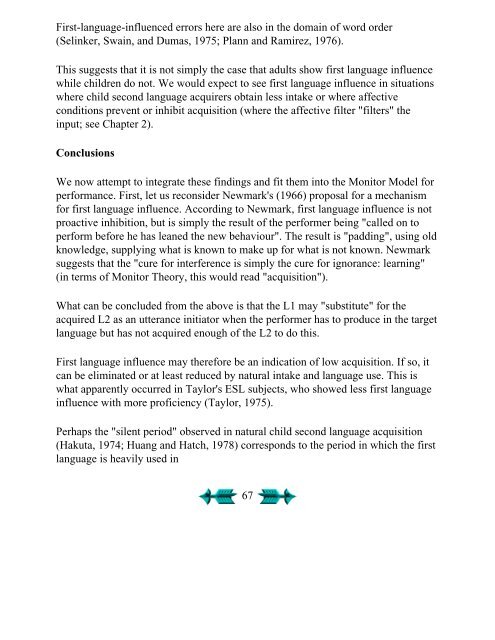Second Language Acquisition and Second ... - Stephen Krashen
Second Language Acquisition and Second ... - Stephen Krashen
Second Language Acquisition and Second ... - Stephen Krashen
You also want an ePaper? Increase the reach of your titles
YUMPU automatically turns print PDFs into web optimized ePapers that Google loves.
First-language-influenced errors here are also in the domain of word order<br />
(Selinker, Swain, <strong>and</strong> Dumas, 1975; Plann <strong>and</strong> Ramirez, 1976).<br />
This suggests that it is not simply the case that adults show first language influence<br />
while children do not. We would expect to see first language influence in situations<br />
where child second language acquirers obtain less intake or where affective<br />
conditions prevent or inhibit acquisition (where the affective filter "filters" the<br />
input; see Chapter 2).<br />
Conclusions<br />
We now attempt to integrate these findings <strong>and</strong> fit them into the Monitor Model for<br />
performance. First, let us reconsider Newmark's (1966) proposal for a mechanism<br />
for first language influence. According to Newmark, first language influence is not<br />
proactive inhibition, but is simply the result of the performer being "called on to<br />
perform before he has leaned the new behaviour". The result is "padding", using old<br />
knowledge, supplying what is known to make up for what is not known. Newmark<br />
suggests that the "cure for interference is simply the cure for ignorance: learning"<br />
(in terms of Monitor Theory, this would read "acquisition").<br />
What can be concluded from the above is that the L1 may "substitute" for the<br />
acquired L2 as an utterance initiator when the performer has to produce in the target<br />
language but has not acquired enough of the L2 to do this.<br />
First language influence may therefore be an indication of low acquisition. If so, it<br />
can be eliminated or at least reduced by natural intake <strong>and</strong> language use. This is<br />
what apparently occurred in Taylor's ESL subjects, who showed less first language<br />
influence with more proficiency (Taylor, 1975).<br />
Perhaps the "silent period" observed in natural child second language acquisition<br />
(Hakuta, 1974; Huang <strong>and</strong> Hatch, 1978) corresponds to the period in which the first<br />
language is heavily used in<br />
67











